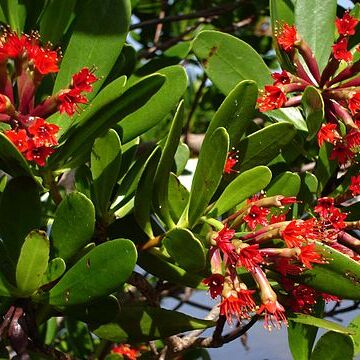Small, evergreen, trees or shrubs. Leaves spirally arranged, sessile or almost sessile, fleshy-coriaceous, entire, glabrous when mature. Flowers hermaphrodite, 5-merous, actinomorphic, red, white, pink or yellow, in short terminal or axillary spikes or racemes. Receptacle (calyx-tube) not externally differentiated into an upper and a lower part but produced to form a tube beyond the ovary, bearing two adnate persistent bracteoles and terminating in a 5-lobed persistent calyx. Petals caducous. Stamens 5-10 borne on the inner wall of the receptacle tube; anthers versatile. Disk absent or inconspicuous. Ovules 2-5; style filiform, persistent, not adnate to the wall of the receptacle; stigma simple. Fruit (pseudocarp) compressed-ellpsoid, obtusely angled, more or less woody, crowned by the persistent calyx.
Small evergreen trees or shrubs. Leaves spirally arranged, sessile or subsessile, fleshy-coriaceous. Flowers hermaphrodite, 5-merous, regular, white, cream, yellow, pink or red, in short terminal spikes or racemes. Receptacle not externally differentiated into an upper and lower part but produced beyond the inferior ovary to form a tube bearing 2 adnate persistent bracteoles and terminating in a 5-lobed persistent calyx (or 5 sepals). Petals 5, caducous. Stamens (5)10, biseriate. Disk inconspicuous. Style filiform, persistent, not adnate to the wall of the receptacle, not expanded at the apex; ovules 2–5. Fruit indehiscent, compressed-ellipsoid and obtusely angled, ± woody, crowned by the persistent calyx. Cotyledons unknown.
Trees or shrubs. Leaves spirally arranged, sessile or nearly so, fleshy, domatia absent. Flowers 5-merous, in short, terminal or axillary spikes or racemes, bisexual. Calyx tube not clearly differentiated from ovary; 2 persistent bracteoles adnate to ovary. Petals glabrous, deciduous. Disc small or absent. Style free, exserted. Ovules 2–5. Fruit compressed, obtusely angled, ± woody, crowned by persistent calyx.


